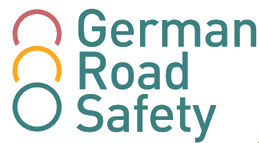Compact Guide
By Bike
Before you ride 00:03
A bike must be roadworthy. It needs functioning brakes, pedals and a bell. Lights are also very important. A bike needs to be lit up from the front and the back as well as have reflectors. The front should have a white reflector attached and the back should have a red one.
The tyres or spokes must be reflective. If not, the spokes must have cat’s eye reflectors attached to them.
Without this equipment a bike is not allowed to be used in traffic. TIP: Many bike shops have less expensive used bikes. These bikes will be sold in roadworthy condition.
Wear light or reflective clothing, so it is easier for others to see you. In addition, we recommend that you wear a bike helmet every time you ride.
You should not ride under the influence of drink, drugs or medication. This can be very dangerous for you and others and carry legal consequences.
While riding 01:32
To maintain balance, grip the handlebars with both hands. If you stop, do not hold on to vehicles around you.
Only one person is allowed to ride a bike.
If you take a small child with you, you need a special child seat. This must be securely attached to the luggage rack. Alternatively there are so-called child trailers.
If you are riding with a cycling group, ride single file – not next to one another. HINT: While you ride you must not make a phone call or use your smartphone. This can cause accidents and carry consequences. While riding you need your full attention.
Bike paths 02:37
In Germany, adults and any persons older than 10 years of age must ride their bike in the road.
Children up to 8 years of age must use the pavement.
Between the ages of 8 and 10, children can decide themselves if they would rather ride in the road or on the pavement.
Children should feel safe in the road and in the best case should have taken a bicycle training course in school.
TIP:
In many cities there are traffic schools, where you and your child can practice cycling under supervision.
More can be found under the Information
![]() tab.
tab.
As soon as a bike path is signposted
![]()
![]()
![]() ,
you must use the available path,
unless there are obstacles barring the path.
Then you may carefully ride out into the road.
,
you must use the available path,
unless there are obstacles barring the path.
Then you may carefully ride out into the road.
If you see this sign (“Shared Cycle and Pedestrian Path”)
![]() ,
this means that pedestrians and cyclists share the path.
Ride carefully and be considerate of pedestrians.
,
this means that pedestrians and cyclists share the path.
Ride carefully and be considerate of pedestrians.
With this sign (“Separate Cycle and Pedestrian Path”)
![]() cyclists must use the side that is noted on the sign and/or marked on the ground.
cyclists must use the side that is noted on the sign and/or marked on the ground.
Bikes are not allowed on highways
![]() and motor roads
and motor roads
![]() .
.
This rule also applies if you see these signs:
“Pavement”
![]() ,
“No cycling”
,
“No cycling”
![]() ,
“No vehicles of any kind”
,
“No vehicles of any kind”
![]() .
.
This sign means you must get off your bike and push it:
![]() .
.
Traffic rules 04:56
Traffic rules for cyclists are the same as for drivers. Red means “Stop!”, so you must also stop.
At a junction with no traffic light or right of way signs, the following applies: Whoever is on the right, has right of way. Therefore, “right before left”.
Safety & hand signals 05:25
If you want to go straight, keep at least 1 metre away from parked cars. You could be hit by a car door if they are opened carelessly.
Keep an eye on entrances and exits. Many drivers overlook the bike path and drive out too far ahead.
If you go straight through a junction, turning vehicles (cars, but especially lorries) might not see you in their “blind spot”. TIP: If you are not sure whether or not you can be seen, it is better to brake and give up your right of way. Always keep enough distance from the other vehicles. You should stop behind a bus or lorry at a light – not next to it.
If you want to turn, first look over your shoulder to observe traffic. Clearly signal with your arm that you want to change your direction of travel. Signal with your left arm out to the side if you want to turn left, and to the right if you want to turn right.
This is especially important so others can see where you want to go.
If, for example, you want to turn right at a junction, be mindful of those on foot. They have the right of way.
We wish you a pleasant ride!

